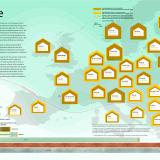U Value
Mark (#33, 2011)
Buildings account for 40 per cent of total energy consumption in the European Union. The most reliable and important way to reduce energy use in buildings is insulation, which can reduce the consumption of energy by as much as 78 per cent.
Although requirements for building insulation are set by individual governments, a directive passed by the European Union – specifically the Energy Performance of Buildings Directive (2010/31/EU) – promotes optimal building insulation. If implemented, this energy saving directive will help the EU to comply with the Kyoto Protocol’s target reduction of greenhouse gases. The EU has asked its member states to promise that by 2020 all new buildings will be ‘nearly zero-energy buildings’. Ever-increasing insulation standards result in ever-thicker walls, roofs and floors, and it is no longer the weight of a building that defines the thickness of an exterior wall but the outdoor climate at the site. Whereas local traditions once determined a building’s appearance, the design of today’s building is based much more on environmental conditions. In some cases, of course, tradition and environment go hand in hand. The average well-insulated exterior wall is two-thirds insulation material and one-third framework. To achieve a standard U-value of 0.20 W/m²K using wood, you would have to build a 62-cm-thick wooden wall. To save space, material and money, you would be forced to cover the outer surface of the building with various materials – layer upon layer – each selected for a specific quality or qualities. No building that is constructed with currently available materials and that complies with contemporary thermal insulation requirements has an outer surface that demonstrates Ruskin’s 19thcentury principle of ‘material honesty’.
The debate he instigated at that time and which continued at a high pitch throughout the entire modernist period was smothered, in the end, by a thick layer of insulation.
producer: Theo Deutinger
